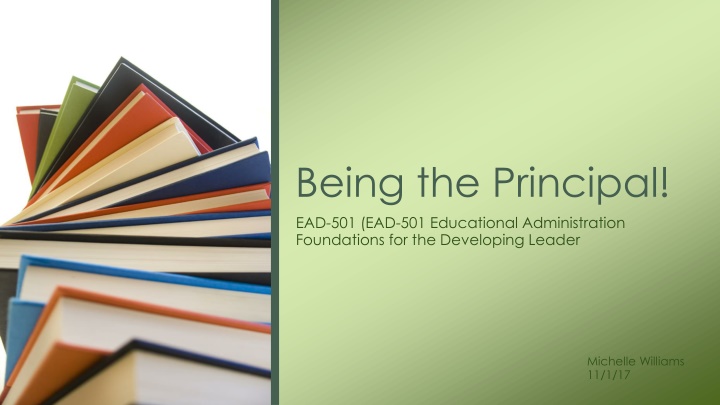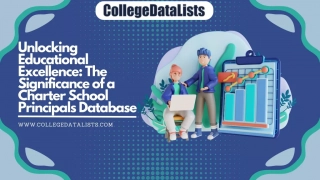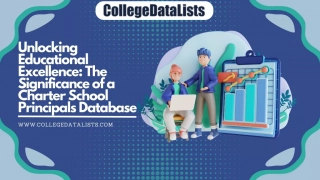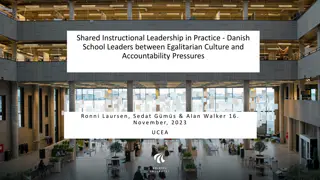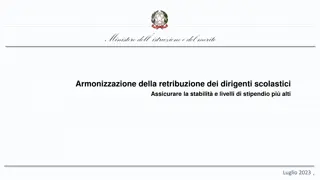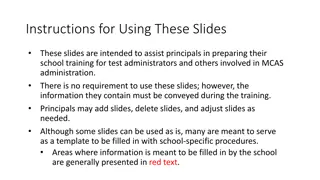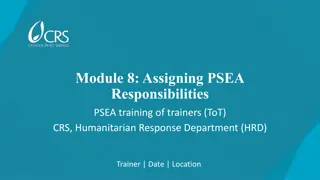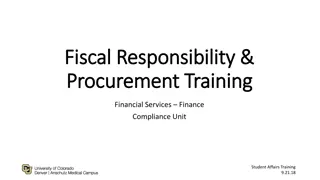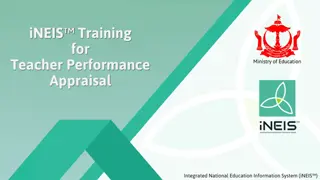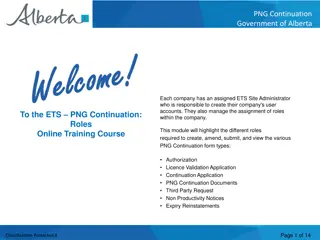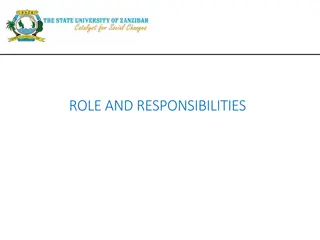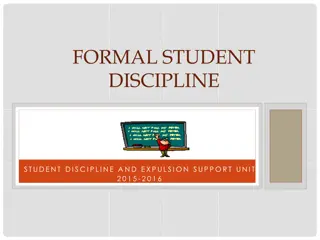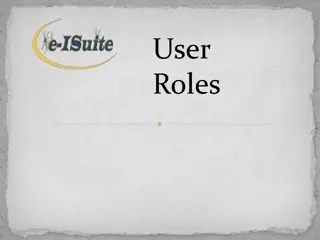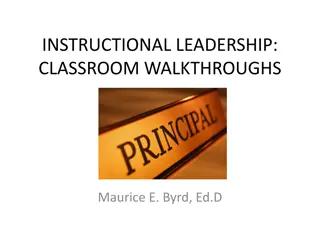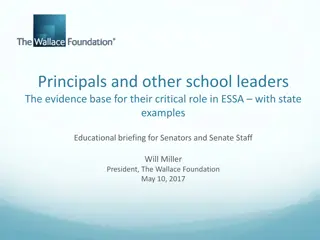Roles and Responsibilities for Principals & Effects on Student Outcomes
This content delves into the roles and responsibilities of principals, as well as the impact they can have on student outcomes. It explores various leadership styles, such as instructional and transformational leadership, and their influence on academic performance. Scholarly articles are presented to support the discussion, highlighting the importance of leadership types in educational settings.
Download Presentation

Please find below an Image/Link to download the presentation.
The content on the website is provided AS IS for your information and personal use only. It may not be sold, licensed, or shared on other websites without obtaining consent from the author.If you encounter any issues during the download, it is possible that the publisher has removed the file from their server.
You are allowed to download the files provided on this website for personal or commercial use, subject to the condition that they are used lawfully. All files are the property of their respective owners.
The content on the website is provided AS IS for your information and personal use only. It may not be sold, licensed, or shared on other websites without obtaining consent from the author.
E N D
Presentation Transcript
Being the Principal! EAD-501 (EAD-501 Educational Administration Foundations for the Developing Leader Michelle Williams 11/1/17
Roles and Responsibilities for Principals Effects principals can have on student out comes Correlations between the six ISLLC standards and Ethics for School Leaders to specific job responsibilities Expectations of a principals State and professional standards Culture of school and communities Job Market Information
Effects Principals Can Have on Student Outcomes Instructional Leadership- works on building a staff that shares a vision. The main focus is planning, evaluating curriculum and progression. Transformational Leadership-States that leaders work with their staff by encouraging them to take a more active role in educating students. Studies have shown that instructional leadership over transformational led to greater gains in student achievement, however transformational leadership coupled with instructional leadership leads to significant gains. It is suggested that School principals gain an understanding of the culture of their school before they select a leadership that they would like to implement.
3 Scholarly Articles to Support Effects Principals Can Have on Outcomes The Impact of Leadership on Student Outcomes: An Analysis of the Differential Effects of Leadership Types Viviane M. J. Robinson Claire A. Lloyd Kenneth J. Rowe Vol. 44, No. 5 (December 2008) 635-674 This article discusses a study that was conducted to analyze the Different effects of leadership styles. It compared transformational and instructional leadership styles The following 5 areas were studied: 1. Establishing goals and expectations, 2. Resourcing strategically, 3. Planning, coordinating, and evaluating teaching and the curriculum, 4. Promoting and participating in teacher learning and development and 5. Ensuring an orderly and supportive environment.
3 Scholarly Articles to Support Effects Principals Can Have on Outcomes cont. The Influence of School Leadership on Student Outcomes Open Journal of Social Sciences Vol.05 No.09(2017), Article ID:79061,9 pages This article was written to examine the effects of transformational and instructional leadership on overall academic student performance. This study focused on teaching and learning, the collaboration of school goals along with the school s vision, and working with the community to improve the school.
3 Scholarly Articles to Support Effects Principals Can Have on Outcomes cont. Educational Administration Quarterly Vol. 44, No. 5 (December 2008) 635-674 The Impact of Leadership on Student Outcomes: An Analysis of the Differential Effects of Leadership Types Viviane M. J. Robinson Claire A. Lloyd Kenneth J. Rowe This article discusses the relationship between transformational and instructional leadership on student outcomes. This research showed that with instructional leadership students were 3 to 4 times higher than transformational leadership. Studies showed transformational leadership did have a positive impact of teacher performance, but did not show in student performance.
Correlations between the Six ISLLC Standards and Ethics for School Leaders Standard 1 is put into place to insure that all students are successful. Standard 1 begins with a vision correlates with making student success a number 1 priority. Standard 2 is put into place for the school leaders to continue to elevate student growth by becoming the voice for student, foster continued growth of student learning and staff educational development and advancement. It also correlates with making student success a number 1 priority. Standard 3 is put into place to further continued student success through management procedures put into place correlates with putting into place appropriate rules and regulations so that educational goals are consistent.
Correlations between the Six ISLLC Standards and Ethics for School Leaders cont. Standard 4 is put into place to insure that the educational leader has a plan for collaborating families, the community and staff correlates with fulfilling personal obligations to the best of your ability. Standard 5 is put into place to insure that the educational leader has a plan for collecting data relating to the learning environment and continuously monitoring the data for student success correlated with always looking for ways to improve the educational program through research and workshops Standard 6 Is put into place to insure that the School leader develops a plan that encourages student success in every child correlates with with making student success a number 1 priority.
So You Want to Be a Principal, You can Expect to: Provide a safe learning environment for every child Develop and implement federal and state rules and regulations Cultivating leadership in others, and assist with developing teachers as leaders. Encourage parental involvement and community support Work with the staff to create a behavior plan that works with your school environment.
So You Want to Be a Principal, Here is what to expect cont. Observe teachers and offer constructive feedback on their performance and give opportunities for reflection. Budget allotted funds to insure that the school has what it needs to be successful Maintain standards based on the North Carolina Standard Course of Study. Examine achievement data and evaluation results Attend Exceptional Children's Individualized education Plan Meetings.
State and Professional Standards A school leader must: Lead the school and prepare students for the 21stcentury Set high standards for instructing students Work to create a school free of cultural biases Provide professional development opportunities organize professional learning communities Adhere to or develop processes for budgeting, problem solving, everyday management
State and Professional Standards cont. Collaborate with organizations to incorporate community support within the school. Encourage leadership within the school
Job Market Employment of elementary, middle, and high school principals is projected to grow 8 percent from 2016 to 2026, about as fast as the average for all occupations. Hours for principal is 40+ hours a week. The work year round. The average pay for a principal is 92,50.00
Job Opportunities in Durham North Carolina Number of job opening as on 11/1/2017 Assistant Principal 1 position Principal 8 positions
Working Conditions Working with students can be rewarding. Working with staff, parents, the community and local education agencies and board members ca be challenging.
Works Cited Council of Chief State School Officers (2008). Educational leadership policy standards: ISLLC 2008. Retrieved from www.ccsso.org/documents/2008/educational_leadership_policy _standards_2008.pdf. North Carolina Standards for School Executives As Approved by the State Board of Education December 2006 and July 2011 Bureau of Labor Statistics, U.S. Department of Labor, Occupational Outlook Handbook, Elementary, Middle, and High School Principals, on the Internet at https://www.bls.gov/ooh/management/elementary-middle-and- high-school-principals.htm https://www.applitrack.com/dpsnc/onlineapp/default.aspx?AppliTrac kPostingSearch=principal https://durhamnc.gov/386/Demographics
Bamburg, J. D., & Andrews, R. L. (1991). School goals, principals, and achievement. School Effectiveness and School Improvement, 2, 175- 191. Marks, H.M. and Printy, S.M. (2003) Principal Leadership and School Performance: An Integration of Transformational and Instructional Leadership. Educational Administration Quarterly, 39, 370-397 Leithwood, K., Sun, J. and Pollock, K., Eds. (2017) How School Leaders Contribute to Student Success: The Four Paths Framework. Springer, New York. The Impact of Leadership on Student Outcomes: An Analysis of the Differential Effects of Leadership Types Viviane M. J. Robinson Claire A. Lloyd Kenneth J. Rowe Vol. 44, No. 5 (December 2008) 635-674
The Influence of School Leadership on Student Outcomes Open Journal of Social Sciences Vol.05 No.09(2017), Article ID:79061,9 pages Educational Administration Quarterly Vol. 44, No. 5 (December 2008) 635-674 The Impact of Leadership on Student Outcomes: An Analysis of the Differential Effects of Leadership Types Viviane M. J. Robinson Claire A. Lloyd Kenneth J. Rowe
